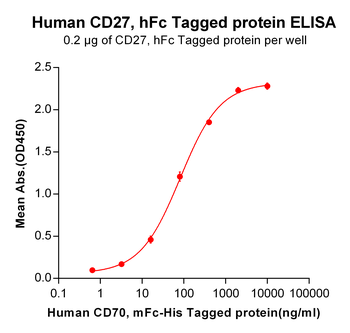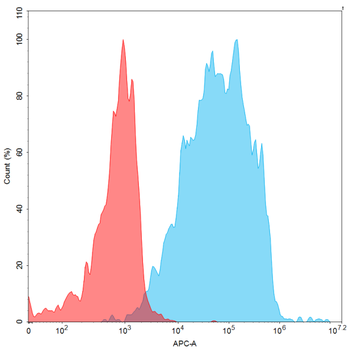You have no items in your shopping cart.
Cart summary
Item 1 of 1
Human RANKL protein
Catalog Number: orb594839
| Catalog Number | orb594839 |
|---|---|
| Category | Proteins |
| Description | Recombinant Human Tumor necrosis factor ligand superfamily member 11(TNFSF11),partial (Active) |
| Tag | Tag-Free |
| Form/Appearance | Lyophilized powder |
| Purity | Greater than 90% as determined by SDS-PAGE. |
| MW | 22.4 kDa |
| UniProt ID | O14788 |
| Protein Sequence | IRAEKAMVDGSWLDLAKRSKLEAQPFAHLTINATDIPSGSHKVSLSSWYHDRGWAKISNMTFSNGKLIVNQDGFYYLYANICFRHHETSGDLATEYLQLMVYVTKTSIKIPSSHTLMKGGSTKYWSGNSEFHFYSINVGGFFKLRSGEEISIEVSNPSLLDPDQDATYFGAFKVRDID |
| Protein Length | Partial |
| Source | E.coli |
| Biological Origin | Homo sapiens (Human) |
| Biological Activity | ①Loaded Recombinant Human OPG-Fc on Pro A Biosensor, can bind Human RANKL with an affinity constant of 1.83 pM as determined in BLI assay. ②Loaded Human RANK-His on HIS1K Biosensor, can bind Human RANK L with an affinity constant of < 1 pM as determined in BLI assay. |
| Expression Region | 140-317aa |
| Endotoxins | Less than 1.0 EU/µg as determined by LAL method. |
| Storage | The shelf life is related to many factors, storage state, buffer ingredients, storage temperature and the stability of the protein itself. Generally, the shelf life of liquid form is 6 months at -20℃/-80℃. The shelf life of lyophilized form is 12 months at -20℃/-80℃. |
| Buffer/Preservatives | Lyophilized from a 0.2 μm filtered 20 mM Tris-HCl, 150 mM NaCl, pH 8.0 |
| Alternative names | CD254; ODF; OPGL; RANK L; TNFSF11; CD254; Osteocla Read more... |
| Background | CD254, also known as RANKL, TNFSF11, TRANCE, OPGL and ODF, is a type II membrane protein of the tumor necrosis factor (TNF) superfamily, and affects the immune system and control bone regeneration and remodeling. RANKL is the ligand of nuclear factor (NF)-κB (RANK). When RANKL binds to RANK, it will undergo trimerization and then bind to an adaptor molecule TNF receptor-associated factor 6 (TRAF6). This results in the activation of several downstream signaling cascades, including the NFκB, mitogen-activated protein kinases (MAPK), activating protein 1 (AP-1), and nuclear factor of activated T cells (NFATc1), resulting in the formation of multinucleated bone-resorbing osteoclasts. RANKL is widely expressed in skeletal muscle, thymus, liver, colon, small intestine, adrenal gland, osteoblast, mammary gland epithelial cells, prostate and pancrea |
| Note | For research use only |
| Application notes | Partial |
| Expiration Date | 6 months from date of receipt. |

(Tris-Glycine gel) Discontinuous SDS-PAGE (reduced) with 5% enrichment gel and 15% separation gel.
Human TNFSF11 Protein, hFc Tag [orb757436]
The purity of the protein is greater than 95% as determined by SDS-PAGE and Coomassie blue staining.
The protein has a predicted molecular mass of 48.4 kDa after removal of the signal peptide.The apparent molecular mass of hFc-TNFSF11 is approximately 55-70 kDa due to glycosylation.
Mammalian
50 μg, 10 μg, 100 μgHuman TNFSF11 / RANKL / CD254 Protein [orb1149290]
Unconjugated
95%
20.5 kDa
Human TNFSF11 Protein, premium grade (orb1149290) is expressed from human 293 cells (HEK293). It contains AA Gly 64 - Asp 245 (Accession # AAC51762.1).
1 mg, 50 μg, 20 μgHuman RANKL protein [orb392615]
ELISA, MS, SDS-PAGE, WB
Greater than 95% as determined by reducing SDS-PAGE.
E. coli
10 μg, 50 μg, 500 μgRANKL/TNFSF11/CD254 Protein, Human, Recombinant (rFc) [orb1953388]
98.00%
46.18 kDa (predicted); 134.21 kDa and 54.28 kDa (reducing condition, due to glycosylation)
100 μg








